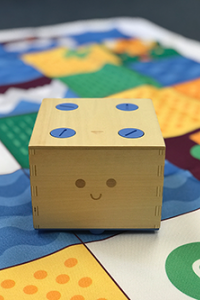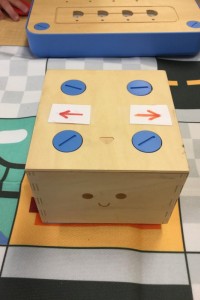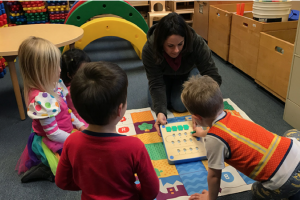Cubetto
Cubetto
Coding in Early Mathematics
In this digital generation, coding products have emerged as a new “hot item”, introducing programming skills to children through playful, hands-on tools. Effective uses of technology can enhance learning (Clements & Sarama, 2002), and incorporating mathematical discussions within children’s coding play, not only fosters children’s mathematical thinking, but these experiences make learning math fun (Gasteiger, 2015).
Introducing Cubetto
 Watching children crawl around the floor as they track a small wooden robot maneuvering across a colorful mat may not seem like the optimal environment to learn foundational math concepts.
Watching children crawl around the floor as they track a small wooden robot maneuvering across a colorful mat may not seem like the optimal environment to learn foundational math concepts.
Upon closer inspection, however, it is evident that these playful explorations with Cubetto encourage children to reflect on key concepts in early mathematics, such as representation and number sense.
Representing Quantities
As they make observations, set goals, and solve problems, children apply mathematical ideas and direct Cubetto to different places on the map. Children can begin their investigations identifying Cubetto’s various movements. Then, children can explore how the tiles’ shape, color, and action represent specific commands (e.g., red “arrow” means right turn).
 Once children have determined the unique movements, they can predict how Cubetto will move based on the tiles on the control board. As children gain experience, they can also make predictions about Cubetto’s final destination or purposefully plan routes from one location to another using various combinations of coding tiles.
Once children have determined the unique movements, they can predict how Cubetto will move based on the tiles on the control board. As children gain experience, they can also make predictions about Cubetto’s final destination or purposefully plan routes from one location to another using various combinations of coding tiles.
Through various explorations, children have opportunities to make connections across the verbal number sequence, visual map spaces, physical coding tiles, and auditory beeps, each of which represents the number of movements Cubetto will make. These experiences offer repeated, purposeful counting tasks where children can begin making connections among multiple representations of number.

For example, when children wanted Cubetto to visit the zoo, they first counted how many squares the robot needed to move forward. Next, they placed five green (i.e., forward) tiles on the control board and directed Cubetto to go. As Cubetto traveled, the children counted each movement and listened to the beeps. In this meaningful context, teachers and children used numbers to describe “how many,” and connected the idea that five green tiles, five forward movements, and five beeps represented the same quantity.
Extension Opportunities
But, Cubetto is not just for preschoolers. As children develop more abstract thinking, they expand from verbal and physical representations to include symbols like written numerals and operation signs or pictorial representations such as diagrams.
In elementary grades, teachers can incorporate contextual representations through challenges that integrate navigation skills or coordinate grids to “program” realistic directions and distances for locations in their schools or community.
Children learn best through relevant tasks based on their questions and inquiries. Using hands-on coding technologies, like Cubetto, can provide valuable opportunities to explore mathematics within a meaningful and playful context.
References
Gasteiger, H. (2015). Early mathematics in play situations: Continuity of learning. In Mathematics and Transition to School (pp. 255-271). Springer, Singapore.
Clements, D. H., & Sarama, J. (2002). The role of technology in early childhood learning. (Early Childhood Corner). Teaching Children Mathematics, 8(6), 340-344.

Add new comment